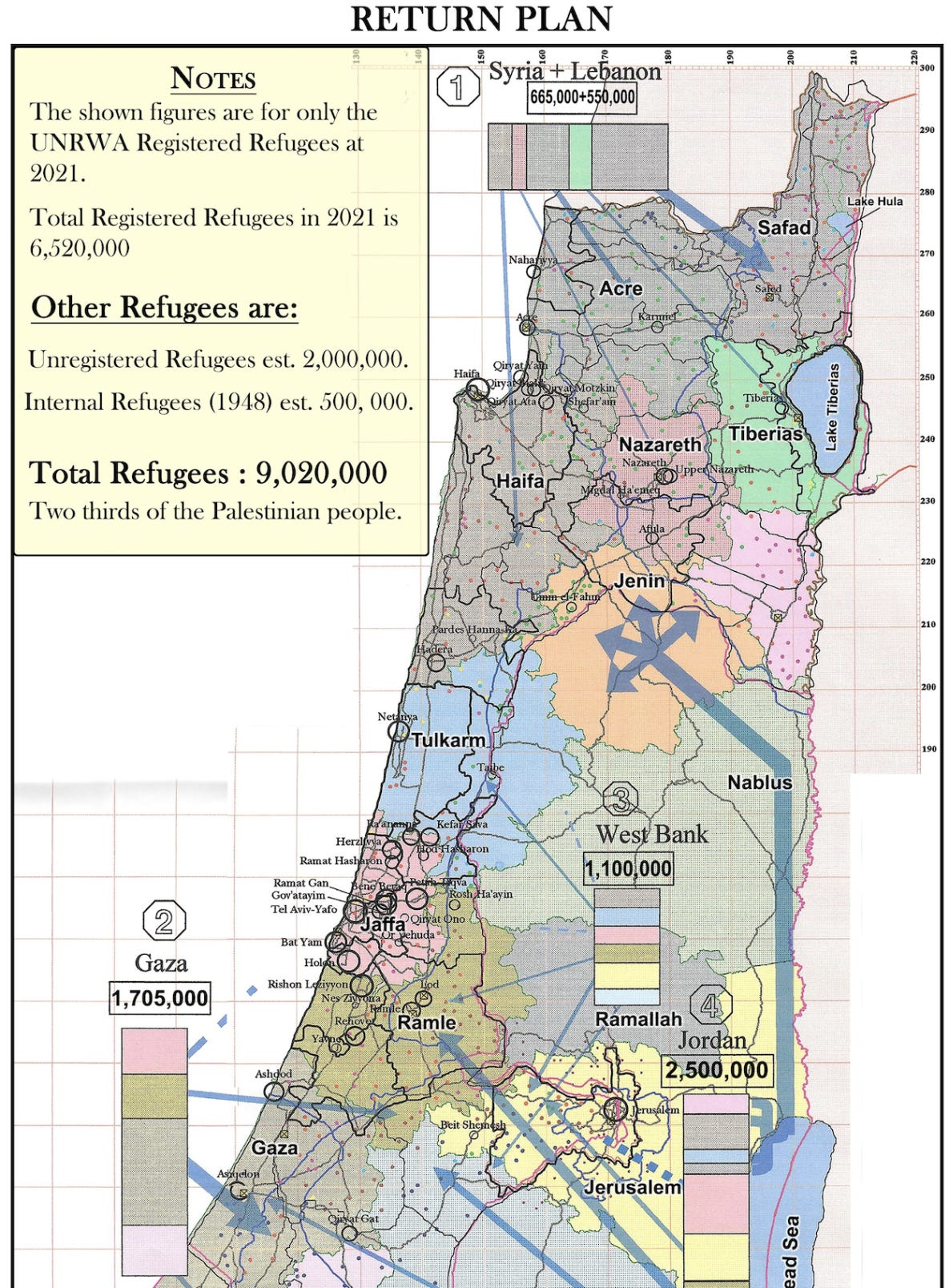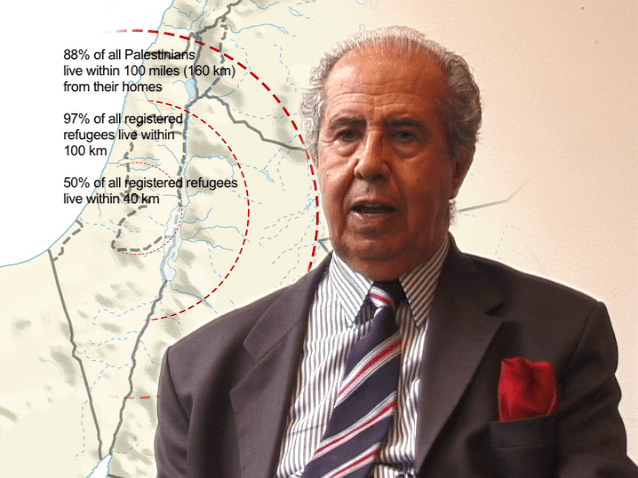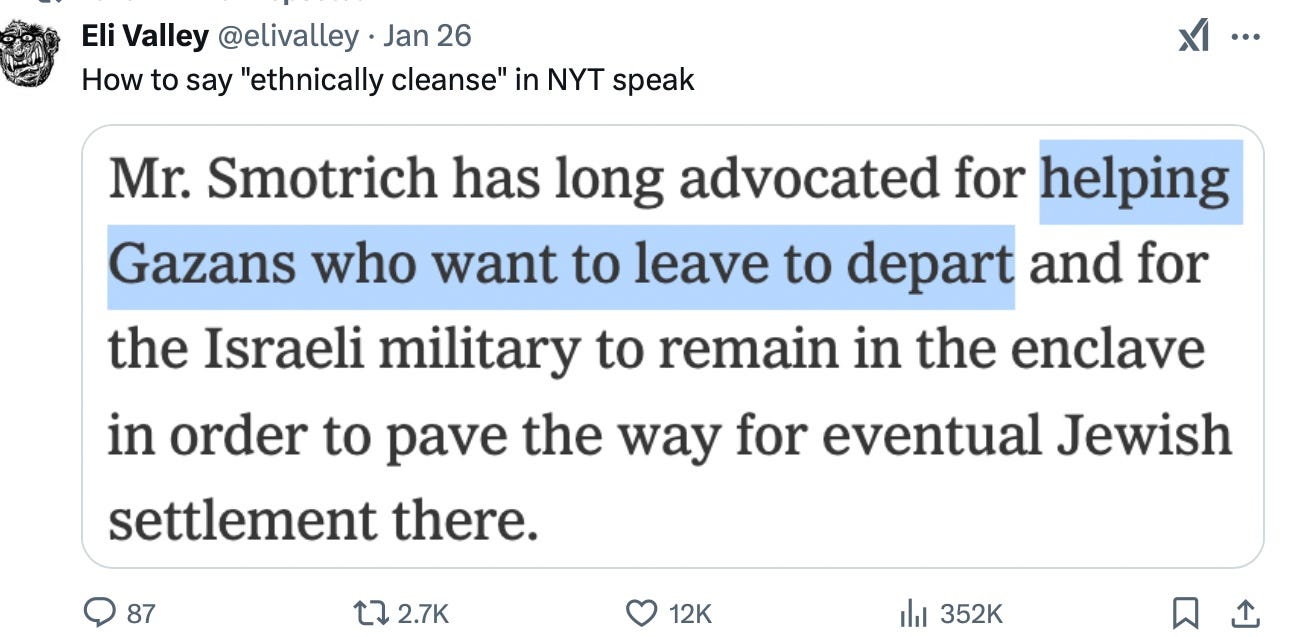Sermons at the Court

Never before have our people truly “returned.” Never before have Palestinian refugees from Gaza ever moved north. From the Palestinian Nakba of 1948 to this historic moment on January 27, 2025, we have only drifted deeper into diaspora. Yet, throughout it all, we have clung to the dream of one day realizing our right of return.
Today, we witness the unimaginable: a million Palestinians heading north—wounded, hurting, and carrying the weight of four generations of pain. And yet, amid the suffering, they smile, chant, and wave the Palestinian flag. This moment carries a meaning far beyond symbolism. The right of return is not just a dream; it is no longer a distant hope. It is a reality. And it begins today—thanks to Gaza, and the immense sacrifices of Gaza’s people. - Gazan veteran journalist Ramzy Baroud
Let me posit this article’s provocative argument from the onset: Palestine today is a land without a people for a people without a land. Confused? Read on.
Images of Gazans on their exodus back to the rubble of their homes in the ravaged northern part of the strip—the Great March of Return—on Monday the 27th, 2025 will go down as one of the most pivotal moments in Palestinian history. Despite a genocide and living through the most inhumane of conditions for 15 months, the Palestinian people have proudly and defiantly declared to their oppressors: “you can destroy our homes but not our spirits. You can try to make our land “uninhabitable” but we will never leave and we are here to stay.”
The age of un-Nakba is finally here.
It is no coincidence that their epic journey of return happened on the same day marking the Isra was Mi’raj, a special occasion in the Islamic calendar marking the Prophet Muhammad ﷺ’s miraculous night journey from Mecca to Jerusalem and his ascension to heaven; an event which came after a year of compounded sorrow and loss for the Prophet. Defying all odds, Gazans have undergone their own metaphorical ascension back to the holy sanctuary of the skeleton of their homes, their dreams, their memories, defying the calculus of those who wish to ethnically cleanse them. In returning to earthly ruin, they rose to celestial heights above their own trauma and sorrow, the limits of human capacity, almost defying the laws of physics. The Gazan Great March of Return will go down in history as one of the most miraculous collective hijras of the spirit.
And yet, we must be careful not to lionize their suffering and the prolonged agony that awaits them still. Despite their legendary sumud, the genocide is not over: people are still sleeping in the rubble and the cold. They are still sick, limbless, tired and weary. The conditions of forced famine and calculated murder are not over. Israel and the US administration are signaling that Gaza is to remain in an “uninhabitable” state, callously boasting that “there is nothing left”, salivating over it as precious real estate that can simply be bought off and annexed by settlers and fascist fat cats, which was their plan all along. The fact that Gazans are so resistant to forced expulsion has made their oppressors all the more enraged and vindictive. “Our soldiers died for nothing,” heaved Ben Givir. Due to this humiliation, they will ramp up genocidal policies such as using hunger as a weapon of war and continue to strangulate the people by preventing the entry of necessary medicines, cement and other building materials that will be crucial for survival in the months ahead.
More than ever, Palestinians will be left to the ravages of the wolves and the schemes of the wicked if they are left in this vulnerable state for much longer. Just the other day, Trump said he wanted to “clean out” Gaza, a sentiment that has been echoed almost verbatim by Kushner last year. This effort to “clean out” Palestinian land has been in play since the Balfour Declaration in 1917, and later on by the British Peel Commission, when, in July of 1937, “Lord” Peel proposed to partitioning of Palestine to create a small Jewish state on about 17 percent of the territory, from which over two hundred thousand Arabs would be cleansed (euphemized as “transferred”).
With this pernicious effort to ethnically cleanse the native Palestinians is more than a century old, to those who ask, where should they go? What should Gazans do? Simple. I am surprised that not more conscientiousness leaders, writers and activists for Palestinian rights are not calling out from this out from the top of their lungs. I wonder why not more voices are uniting to advocate for the most humane, logical and necessary pathway forward: Palestinians should return home. Simple. No, not just the Gaza were they all forced into in 1948. But their original home. Their pre-1948 villages, should they wish, or wherever the hell they please. End the occupation. End the siege. Give them the freedom to return, to move freely. To live as equal human beings, not as cattle to be moved from one cage to another. Just listen to the words of this wise woman named Um Usama al-Azazi, whom I hope is still alive, echo the same sentiment back in March 2024, when Israel used (and continues to use) hunger as a weapon of war by shutting down UNRWA:
Palestine today is a land without a people for a people without a land.
To return to this post’s key argument: I don’t mean to be provocative by re-hearsing this Zionist, colonial adage. Of course, Palestinians always had a land, but it was stolen from them and their greatest struggle is the Right of Return to their land, hence the “currently without a land” part. You may be triggered by this pernicious, propagandist phrase before as it was used to justify the Zionist colonization of Palestine to establish a Jewish homeland in the 19th and 20th centuries, but today, the slogan has turned firmly on its head.
It is perhaps the highest manifestation of poetic justice that the phrase once used to colonize Palestine has today would come to be applicable to the right of Palestinian return. “A land without a people for a people without a land,” used today for the Palestinians, reveals the nakedness of the brutal and ongoing Israeli plan to ethnically cleanse Palestine of its native population.
Let me explain.
It is a little discussed fact that 87 percent of Jewish Israelis live on only 12 percent of the land they took to create the state of Israel.
Read that again: 88% of the land known as historic Palestine has been ethnically cleansed but remains uninhabited. This completes the other half of my argument, that the ethnically cleansed lands of 1948, hence the “land without a people” part, because the majority of Zionist colonizers do not actually live in the lands they ethnically cleansed. They are empty. Uninhabited.
Why don’t more people speak of this? I don’t know. When I discovered this glaring, naked fact in the life’s work of veteran Palestinian historian, geographer and Nakba survivor Salman Abu Sitta—the key expert on the inalienable Right of Return alive in the world today—I started telling everyone with an interest in Palestine about him and his work. Here, he explains his simple, genius vision:
“In my research, I found that 88% of Israel’s Jewish population resides in only 12% of the land, specifically in three major areas: Tel Aviv, Haifa, and West Jerusalem. The rest of the land is either militarized or occupied by kibbutzim, which were deliberately planted not as organic farming communities, but as fortified military outposts designed to keep Palestinian refugees from returning. These settlements were surrounded by trenches, barbed wire, and machine guns, particularly near Gaza, West Jerusalem, and the Lebanese border. The land outside of these concentrated areas is largely uninhabited, which presents a clear opportunity for the return of Palestinians without displacing anyone.” (Source: Jurist.org)
It is also a little discussed fact that most displaced Palestinians still live within historic Palestine. This fact enrages Israel and it is why it continues to pummel Gaza, the West Bank and defenseless refugee camps where approximately 80% of the world’s displaced Palestinians today still live. Camps such as Jenin, Balata, Rafah, Khan Younis, Jabaliya, Kalandia and Dehaisha have, for decades, witnessed forced expulsions, nightly terror raids, targeted bombings, and now—genocide. Jenin, the "fortress of resistance” in the West Bank is under siege as I write this, for the same reason the genocide in Gaza occurred: to ethnically cleanse and terrorize the native inhabitants of the land, the Palestinians. A fool’s errand.
If the last 15 months have shown us anything, it is that in spite of experiencing the largest, longest and most brutal ethnic cleansing campaign in human history, the Palestinian people remain steadfast as estranged refugees in their own land, a land that Israel is still fiercely and violently scrambling to genocide its native population. The mass expulsion of over 750,000 natives since 1948, representing the largest forcible displacement in modern history, gave Israel imagined sovereignty over the entire land historically known as Palestine. But in terms of actual inhabitance by migrant Jewish settlers, it only covers a small swath of the colonized land.
This makes the land scramble in historic Palestine an ongoing and unfinished project. This fact the Great March of Return this week represents, for the first time, the most significant, realistic call for the Right of Return in contemporary history. It is the heralding the age of un-Nakba. This much is clear: the Nakba never ended but the Gazans said: the buck stops here. They refused to seal their fate again to expulsion, to “catastrophe.” Their symbolic return has signaled the beginning of the end of a long, ethnofacist, violent genocidal 76-year episode. Taking cues from the people of Gaza, is time to take the Right of Return seriously.
For the likes of Abu Sitta, this oft un-discussed, yet glaring paradox, is the impetus for his life’s work. Advocating for the ironclad doability of return, “the emperor has no clothes,” he has cried repeatedly over the decades. Israel has no clothes. Its colonial project is weaker than it actually is. Palestinian villages await their rightful owners to come back. With these facts obscured, then, it is clear that the occupation is not only physical, it is mental.
I have a special affinity for Abu Sitta because he reminds me of my maternal grandfather, Jiddo Jamal, a fellow Nakba survivor from Bir as-Sabe’. Like Abu Sitta, he was a young boy when his family was forcibly expelled from Bir as-Sabe’ in 1948, so his impressive and prolific research documenting the Nakba can, perhaps, be seen as a homage of sorts to his the stolen boyhood of the men in my life. When he looks at Israel’s unending colonial scheme, he can easily say “the emperor has no clothes” because he sees what others do not: the nakedness and fragility of its true, ugly reality.

At the age of 22, Abu Sitta devoted his life to obtaining aerial images of Palestine from none other than the British military archive—another form of perfect, poetic justice. He collected an enormous archive of maps, photographs and memos, which culminated to the establishment of the and founded the Palestine Land Society (PLS) and the Palestine Land Studies Center (PLSC) at the American University of Beirut (AUB): the world’s most important database on the viability of the Right to Return.
Today, at 87 years old, Dr. Abu Sitta is recognized as the world’s most important authority on the ethnic cleansing of 1948, not only for his work on the socio-geographical history of Palestine, but for developing a practical plan for implementing the right of return toward a one-state solution. He authored over four hundred studies on the right of return, published four essential atlases on Palestine.
Now more than ever, Abu Sitta’s logical, ethical and humane vision for return needs to be taken seriously:
“The return is easily manageable. We have a huge database and we know who the refugees are, by name, by family, by village of origin, what they own, the limit of their land and where they are exiled today, in which camp or country. Many can walk to their homes, literally within sight. Most can take a one or two-hour bus ride. They can rebuild their homes at the exact spot of their destroyed village. Ninety percent of the village sites are still vacant. There are enough Palestinian engineers and skilled workers to build the needed one million dwelling units.
Our studies have shown that the total return of refugees can be achieved in phases which would take at most 6 to 8 years to complete. An added advantage is that the cost of return is much cheaper than the compensation for stolen land and property, which could reach $500 billion. It is definitely cheaper than the subsidy paid by the US for Israel’s economy and military which runs into $110 billion and counting.”(Source: The Right to Return is Inevitable)
When the “international community” treated the Right of Return as an impossible, insurmountable predicament, Abu Sitta looked at the maps, got the facts and the data straight, and was able to expose Israel for its biggest fig leaf: the simple fact that the majority of Palestinian lands colonized are still there. Empty. Sitting in waiting for its rightful owners to return. Abu Sitta and others do not dwell in the defenseless world of unending lament over “stolen keys” and “old coins” proving that Palestine once was. He—like the people of Gaza—actually see it as a living reality. The rest of simply need to wake up and catch up to that reality.
This is the kind of crystal clear narrative towards tangible liberation Palestinians need from their supporters and allies: not one based not on reactionary rage on social media and protests only, but an organized vision based on facts, empowerment and possibility. One that unapologetically sees the Right of Return as wholly attainable and within grasp, armed by the protection of the law, the arch of history, and the inevitable march of time towards justice. Gazans have shown us with their Herculean sacrifices that this is not only possible, but a reality. They fought with life and limb for their land. The best thing that those who advocate for their rights can do for them now, is to defend and promote their Right to Return, otherwise, we are leaving Palestinians prey to the pernicious plots of one of the most Zionist administrations in US history, one that is hellbent on “cleaning out” Palestine. Time is of the essence.
Narrative is everything. Those who support the movement for Palestinian rights must stress the Right of Return in full force as the only ethical, humane and just path forward. The Palestinians have suffered for far too long. It is a stain on every living person’s humanity that they should bear the cross of the bloody double standard of the “ruse based order.” This travesty of injustice has endured long enough, as have the false, soothsaying promises of a “two state solution.” The “peace process” was nothing but theater doubling as a glorified land grab for Israel. This has led to the fascistic deadlock we are in today: one that refuses, at any cost, to humanize Palestinians. But the world can restore some modicum of justice if we simply restore the beeline of each refugee camp and connect it to the land its inhabitants were originally expelled from. By implementing this (way, way overdue) Right of Return, we not only attain a path of just, literal return, but a figurative one too: we fully wrestle back the information war on Palestine and destroy the mental siege.
Now is the ripest time to reframe our understanding of the inevitability of Return and get out of our mental deadlocks, educate ourselves, and see the facts for what they truly are: Palestine is a land without a people for a people without a land. Even though they have no military power and no “powerful friends,” they have have the most powerful friend of all and something Israel can never destroy: holding on to the rope of Allah, and their indefatigable human spirit. By the power of that unrelenting spirit, they can return.
They will return home, inshAllah.






No comments:
Post a Comment